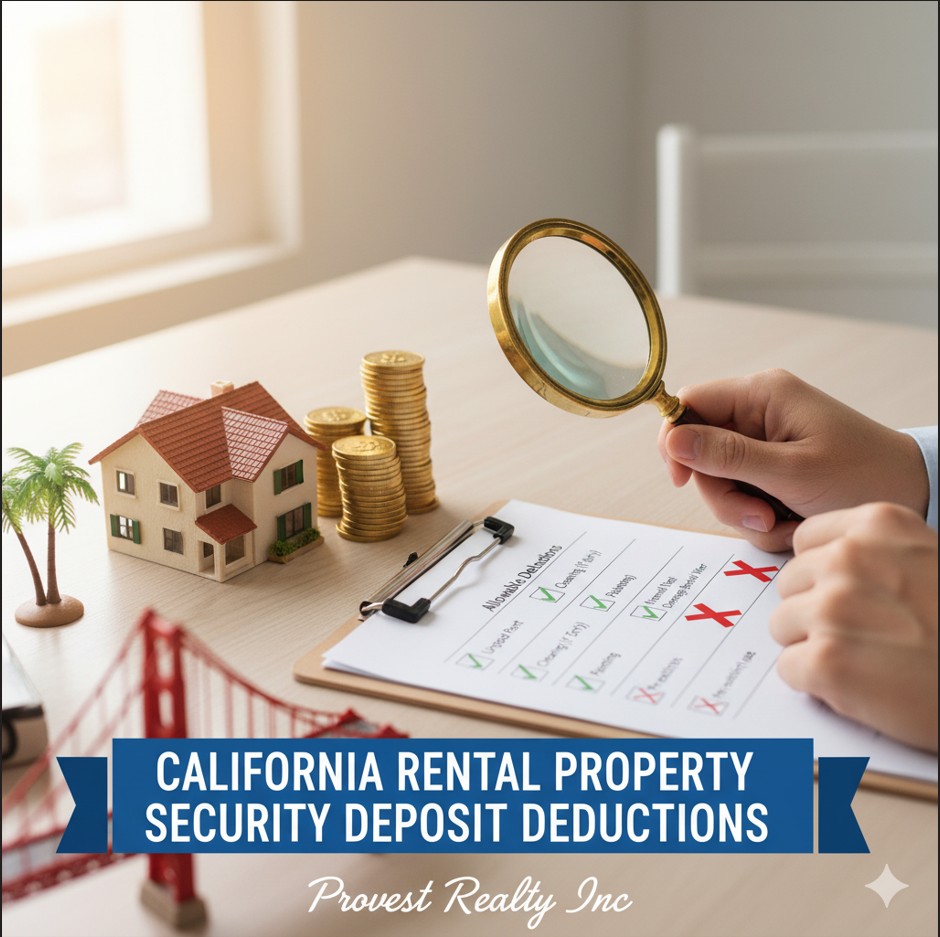What Landlords Can — and Can’t — Deduct from a Tenant’s Security Deposit in California
As a landlord in California, knowing what you can legally withhold from a tenant’s security deposit is essential. Under California Civil Code § 1950.5, the law clearly limits what deductions are allowed — and failing to follow the rules can lead to serious legal trouble.
The Legal Basis: California Civil Code § 1950.5
Security deposit rules in California are governed by Civil Code § 1950.5. This statute defines:
What “security” is used for (e.g., unpaid rent, repairs, cleaning). FindLaw Codes+1
Prohibitions on deductions for ordinary wear and tear or pre-existing damage. California.Public.Law+2Law Office of David Piotrowski+2
Requirements for a pre-move-out inspection. Superior Court of Santa Clara County+1
Deadlines for returning deposits and providing itemized statements. Self-Help Guide to the California Courts+1
Documentation obligations (receipts, invoices, description of work, reasonable rates). California.Public.Law+1
Penalties for bad-faith withholding. Law Office of David Piotrowski+1
What Landlords Can Deduct
Under § 1950.5, the law allows landlords to withhold funds from a security deposit for certain legitimate reasons:
Unpaid Rent (and Related Defaults)
Landlords can apply the deposit toward unpaid rent or other lease-specified defaults. FindLaw Codes+1Repairs for Tenant-Caused Damage
You can deduct for damage beyond ordinary wear and tear. That includes holes in walls, broken fixtures, significant stains, or other damage caused by the tenant or their guests. California.Public.Law+2First Tuesday Journal+2Cleaning Costs
A landlord may charge for cleaning only to restore the unit to the same level of cleanliness as at move-in, not to make it “brand new.” California.Public.Law+1Importantly, professional cleaning (like carpet cleaning) is deductible only if reasonably necessary to return the premises to its original condition (excluding normal wear and tear). FindLaw Codes+1
Replacing Landlord-Provided Items
If the lease provides for certain items (e.g., keys, appliances) and they’re damaged or lost, you may deduct to restore or replace them — again, not to upgrade them. First Tuesday Journal+1
What Landlords Cannot Deduct
Just as important, here’s what is off-limits when withholding from a security deposit:
Ordinary Wear and Tear
This is explicitly barred under § 1950.5(e). Examples include faded paint, minor scuffs, small nail holes, or carpet worn from normal use. Law Office of David Piotrowski+2tenantstogether.org+2Pre-Existing Damage
Landlords may not deduct for damage or defects that existed before the tenant moved in. California.Public.Law+1Upgrades or Cosmetic Improvements
The law limits deductions to restoring to the condition at move-in — not improving or upgrading fixtures. California.Public.Law+1Excessive or Unjustified Cleaning
If the tenant left the unit in a reasonably clean state, you can’t charge for deep cleaning just because you'd prefer it. RentableNon-Refundable Deposit Clauses
Under § 1950.5, you cannot label any portion of the security deposit as “non-refundable.” Law Office of David Piotrowski
Procedural Requirements & Best Practices
Following the law isn’t just about what you deduct — it’s also about how you go about it.
Pre-Move-Out Inspection Option
You must notify the tenant in writing of their right to a pre-move-out inspection, typically during the last two weeks of tenancy. California.Public.Law
If they request the inspection, you must provide an itemized list of potential repairs or cleaning issues so the tenant can fix them before moving out. California.Public.Law
Return and Itemized Statement
Within 21 calendar days after the tenant vacates, you must either refund the deposit in full or provide an itemized statement explaining the deductions. Self-Help Guide to the California Courts
If deductions exceed $125, you must include receipts or invoices, or, if you (or your employee) performed the work, a description of labor, hours, and a reasonable hourly rate. Self-Help Guide to the California Courts+2California.Public.Law+2
Documentation & Evidence
As of recent updates, landlords should maintain before-and-after photos of the unit to support deductions. Rentable
Keep detailed records, including invoices for materials, time spent on repairs, and receipts.
Penalties for Non-Compliance
If you don’t provide the itemized statement or return the remaining deposit within 21 days, you risk forfeiting your right to keep any portion of it. FindLaw Codes
If the withholding is found to be in bad faith, you may be liable for up to twice the amount of the deposit. First Tuesday Journal+1
Why Compliance Matters (and How It Helps You)
Following the law closely isn’t just about avoiding lawsuits — it’s good business:
Builds Trust with Tenants. When tenants see fair, well-documented deductions, they’re less likely to dispute or sue.
Reduces Risk. Proper documentation (photos, invoices, itemization) provides a strong defense if there is a dispute.
Avoids Costly Penalties. Bad-faith withholding or failure to comply with § 1950.5 can lead to doubling the security deposit in damages.
Summary
Allowed deductions: unpaid rent, tenant-caused damage beyond normal wear, cleaning to restore move-in condition, replacement of landlord-provided items.
Not allowed: ordinary wear and tear, pre-existing damage, cosmetic upgrades, labeling anything “non-refundable.”
Procedural rules: pre-move-out inspection (if requested), 21-day deadline, itemized statement, receipts/invoices, reasonable rates, and proper documentation.
Legal exposure: failure to comply can lead to penalties, including double damages in bad-faith cases.
Understanding and applying Civil Code § 1950.5 is critical for California landlords. When deductions are reasonable, backed by documentation, and handled transparently, you protect your property — and your legal standing.
Provest Realty has successfully managed the settlement of hundreds of tenant security deposits, consistently ensuring all disbursements are handled in a professional, fair, and fully compliant manner with all applicable local, state, and federal regulations. As part of our services, we are happy to guide our clients through this highly detail oriented process and help to ensure they have all necessary documentation, completing this task on time, and stay compliant.


